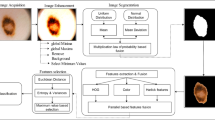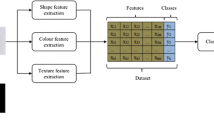Abstract
Recent diagnostic observations have raised concerns regarding malignancy issues in untreated skin cancer. Over the last two decades, dermoscopy has led to non-invasive clinical diagnosis of cancer types, typically Melanoma, Basal Cell Carcinoma (BCC), and Squamous Cell Carcinoma (SCC). Raising concerns coupled with clinical (image) data motivated this study which focuses on a Machine Learning (ML) based approach to properly classify the skin cancer into one of the three types mentioned earlier. In this regard, the study also uses a unique image pre-processing network which cleans and processes the images prior to injection into the ML models. In this study, the image pre-processing network primarily comprises of Gaussian noise removal, blackhat operation, and Otsu segmentation. Post processing, a novel Hybrid Color Features (HCF) algorithm has been used for feature extraction in terms of texture, shape and color features. Outlier handling was done using the z-score rescaling approach. In comparison to the traditional ML approach, it had been observed that the novel soft voting ensemble classifier (SVEC) exhibited better results. The SVEC along with boosting fetched an accuracy of 95.5%, 96.3%, and 96.7% for Melanoma, BCC, and SCC skin cancers, respectively. Peer comparison with prior ML initiatives further confirmed the novelty of the SVEC approach.







Similar content being viewed by others
Data availability
The authors hereby declare that the data associated with study is publicly available.
References
Farajnia S (2020) Overcoming the data gap for the remote diagnosis of skin cancer. Patterns (N Y) 1:100117
Moldovanu S, Damian Michis FA, Biswas KC et al (2021) Skin lesion classification based on surface fractal dimensions and statistical color cluster features using an ensemble of machine learning techniques. Cancers. https://doi.org/10.3390/cancers13215256
Chakraborty C (2019) Advanced classification techniques for healthcare analysis. IGI global, Hershey
Fuduli A, Veltri P, Vocaturo E, Zumpano E (2019) Melanoma detection using color and texture features in computer vision systems. Adv Sci, Technol Eng Sys J 4:16–22
Sreelatha T, Subramanyam MV, Giri Prasad MN (2021) Shape and color feature based melanoma diagnosis using dermoscopic images. J Ambient Intell Humaniz Comput 12:5371–5380
Rehman A, Khan MA, Mehmood Z et al (2020) Microscopic melanoma detection and classification: a framework of pixel-based fusion and multilevel features reduction. Microsc Res Tech 83:410–423
Khasanah N, Komarudin R, Afni N et al (2021) Skin cancer classification using random forest algorithm. SISFOTENIKA 11:137
Paja W, Wrzesien M (2013) Melanoma important features selection using random forest approach. 2013 6th International conference on human system interactions (HSI)
Janney JB, Bethanney JJ, Emalda Roslin S (2020) Classification of melanoma from dermoscopic data using machine learning techniques. Multim Tool Appl 79(3713):3728
Alfed N, Khelifi F (2017) Bagged textural and color features for melanoma skin cancer detection in dermoscopic and standard images. Expert Syst Appl 90:101–110
Pathan S, Aggarwal V, Gopalakrishna Prabhu K, Siddalingaswamy PC (2019) Melanoma detection in dermoscopic images using color features. Biomed Pharmacol J 12:107–115
Soumya RS, Neethu S, Niju TS, et al (2016) Advanced earlier melanoma detection algorithm using colour correlogram. In: 2016 International conference on communication systems and networks (ComNet). IEEE
Sabouri P, GholamHosseini H, Larsson T, Collins J (2014) A cascade classifier for diagnosis of melanoma in clinical images. Conf Proc IEEE Eng Med Biol Soc 2014:6748–6751
Seeja RD, Suresh A (2019) Deep learning based skin lesion segmentation and classification of melanoma using support vector machine (SVM). Asian Pac J Cancer Prev 20:1555–1561
Hagerty JR, Stanley RJ, Almubarak HA et al (2019) Deep learning and handcrafted method fusion: higher diagnostic accuracy for melanoma dermoscopy images. IEEE J Biomed Health Inform 23:1385–1391
Thurnhofer-Hemsi K, Domínguez E (2021) A convolutional neural network framework for accurate skin cancer detection. Neural Process Lett 53:3073–3093
Kuhn M, Johnson K (2019) Feature engineering and selection: a practical approach for predictive Models. CRC Press, Boca Raton
Zhang C, Ma Y (2012) Ensemble machine learning: methods and applications. Springer, Berlin
Manne S, Heckman CJ, Kashy D et al (2022) Moderators of the effects of mySmartSkin, a web-based intervention to promote skin self-examination and sun protection among individuals diagnosed with melanoma. Ann Behav Med. https://doi.org/10.1093/abm/kaab104
Schwartz RA (2012) Skin cancer: recognition and management. Springer, Berlin
Peter Soyer H, Argenziano G, Hofmann-Wellenhof R, Zalaudek I (2019) Dermoscopy e-book: the essentials. Elsevier, Armsterdam
Maiti A, Chatterjee B (2020) Improving detection of Melanoma and Naevus with deep neural networks. Multim Tool Appl 79:15635–15654
Maiti A, Chatterjee B, Santosh KC (2021) Skin cancer classification through quantized color features and generative adversarial network. Int J Amb Comp Intell 12:75–97
Jana E, Subban R, Saraswathi S (2017) Research on skin cancer cell detection using image processing. 2017 IEEE International conference on computational intelligence and computing research (ICCIC)
Gabrielli A (2019) Mean-variance and mean-variance-correlation neural network regression models. SSRN Electr J. https://doi.org/10.2139/ssrn.3438332
Mohan J (2014) Exploring invariant hybrid color image features for face recognition under illumination variation
Najarian K, Splinter R (2016) Biomedical signal and image processing. CRC Press, Cambridge
Rajbongshi N, Bora K, Nath DC et al (2018) Analysis of morphological features of benign and malignant breast cell extracted from FNAC microscopic image using the pearsonian system of curves. J Cytol 35:99–104
Nixon M, Aguado A (2019) Feature extraction and image processing for computer vision. Academic Press, Cambridge
Zheng A, Casari A (2018) Feature engineering for machine learning: principles and techniques for data scientists. O’Reilly Media Inc, Sebastopol
Ciaburro G, Kishore Ayyadevara V, Perrier A (2018) Hands-on machine learning on google cloud platform: implementing smart and efficient analytics using cloud ml engine. Packt Publishing Ltd, Birmingham
Cao XH, Stojkovic I, Obradovic Z (2016) A robust data scaling algorithm to improve classification accuracies in biomedical data. BMC Bioinfor 17:359
Thiagarajan JJ, Sattigeri P, Ramamurthy KN, Kailkhura B (2016) Robust local scaling using conditional quantiles of graph similarities. In 2016 IEEE 16th international conference on data mining workshops (ICDMW) 762–769
Sherazi SWA, Bae J-W, Lee JY (2021) A soft voting ensemble classifier for early prediction and diagnosis of occurrences of major adverse cardiovascular events for STEMI and NSTEMI during 2-year follow-up in patients with acute coronary syndrome. PLoS ONE 16:e0249338
Hussain A, Choi H-E, Kim H-J et al (2021) Forecast the exacerbation in patients of chronic obstructive pulmonary disease with clinical indicators using machine learning techniques. Diagnostics (Basel). https://doi.org/10.3390/diagnostics11050829
Brownlee J (2020) Imbalanced classification with python: better metrics, balance skewed classes, cost-sensitive learning. Machine Learning Mastery
Stanley RJ, Stoecker WV, Moss RH (2007) A relative color approach to color discrimination for malignant melanoma detection in dermoscopy images. Skin Res Technol 13:62–72
Kasmi R, Mokrani K (2016) Classification of malignant melanoma and benign skin lesions: implementation of automatic ABCD rule. IET Image Proc 10:448–455
Author information
Authors and Affiliations
Corresponding author
Ethics declarations
Conflict of interest
The authors declare no conflict of interest.
Additional information
Publisher's Note
Springer Nature remains neutral with regard to jurisdictional claims in published maps and institutional affiliations.
Rights and permissions
Springer Nature or its licensor (e.g. a society or other partner) holds exclusive rights to this article under a publishing agreement with the author(s) or other rightsholder(s); author self-archiving of the accepted manuscript version of this article is solely governed by the terms of such publishing agreement and applicable law.
About this article
Cite this article
Maiti, A., Sultana, M. & Bhattacharya, S. Detection of skin cancer through hybrid color features and soft voting ensemble classifier. Innovations Syst Softw Eng (2022). https://doi.org/10.1007/s11334-022-00498-8
Received:
Accepted:
Published:
DOI: https://doi.org/10.1007/s11334-022-00498-8




